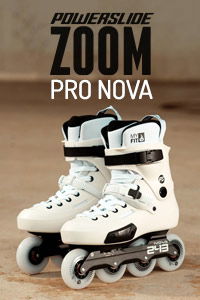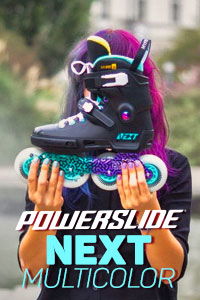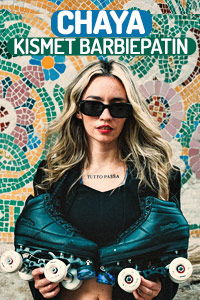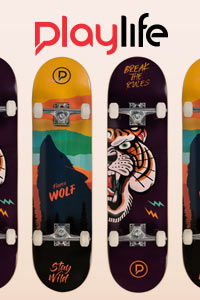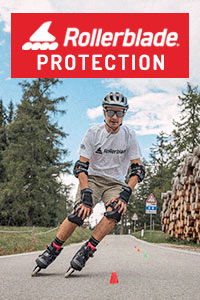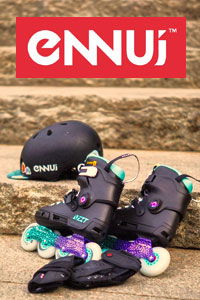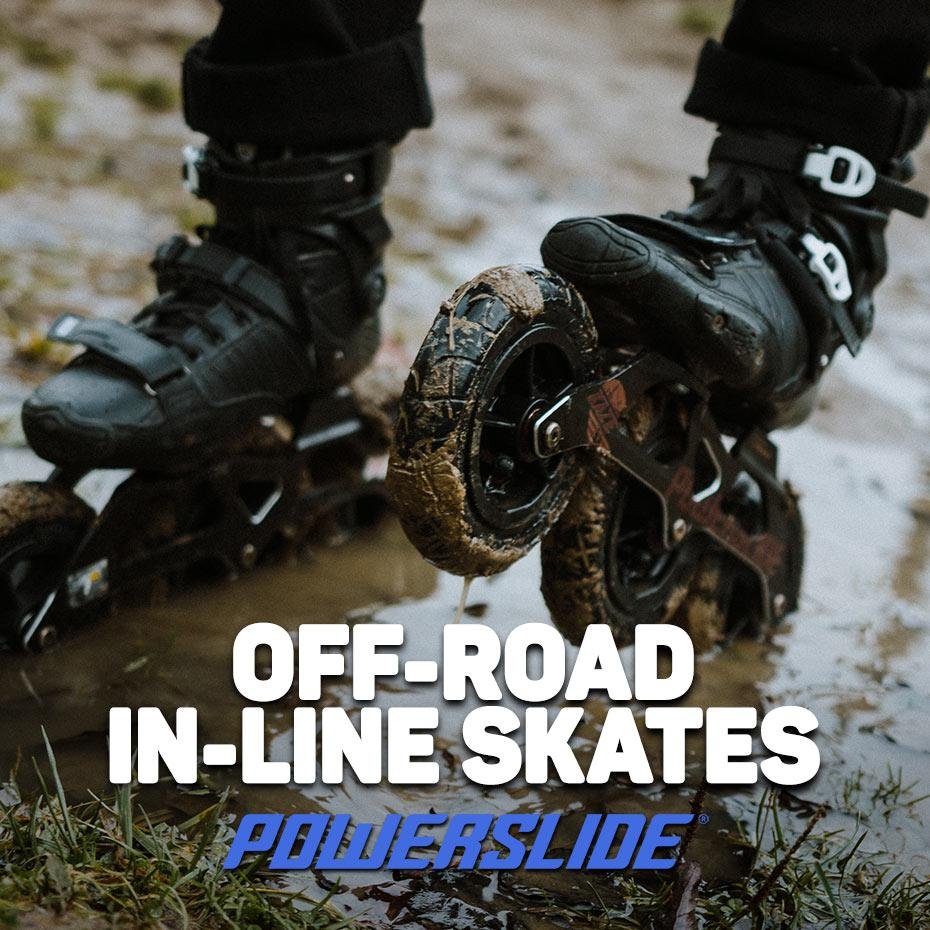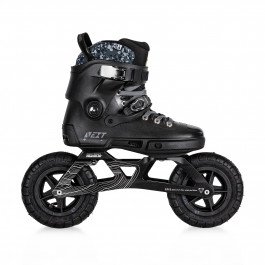If you are visiting our site, the high chances are that all you associate skating with is rolling on smooth concrete and asphalt, with a side dish of some urban/street/skatepark thrown in. Yup, the skates are 100% dependant on these two of the oldest construction materials known to humankind. But what if we tell you that there’s a way to use skates to get closer to nature?
Off-road skates history, abridged.
It may seem not like it, but off-road skates are around since 90’s. The first notable and successful design was Rollerblade Coyote, which looks almost like current off-road skates. Coyotes had three, big, pneumatic wheels and a hardboot with a (very) high cuff. Roces have also tried to come up with something, releasing two models based on different frames, with Big Cat being the more known one. These were resembling roller skis more than inline skates, though.
For more than a decade the idea was abandoned. That is, until Powerslide has started to release “Nordic” skates – again, a more roller ski like design, but coming with 125 mm tires. These were a good option to explore flat areas and gentle hills and really needed a pair of roller ski poles to work well. Definitely not a gear to go nuts in a rough terrain.
This has changed in early 2010’s, when Germans have went back to Rollerblade’s idea of more skate-like design with three wheels. These skates were named “SUV” and first ones came with three 125 mm wheels and Metro(polis) or Imperial hardboot.
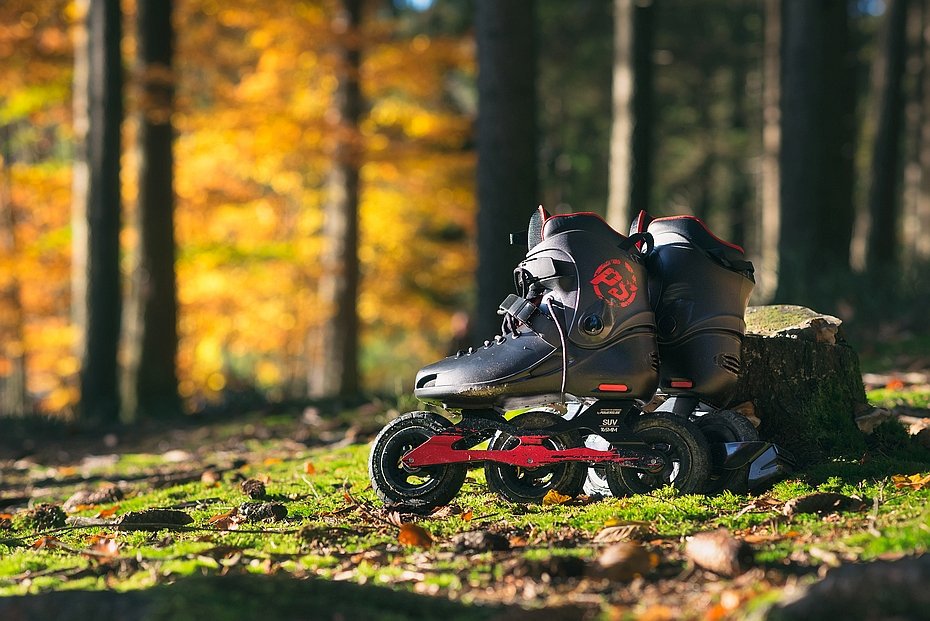
Unlike in Coyotes, there was no unique frame attachment – these used 165 mm spacing mount, which allowed the frames to be put on any compatible boot. Powerslide have been quick to offer full frame sets (with wheels, tires, bearings and so on) as and option for those who would want to turn their existing skates into off-road ones. Even though the basic template of skates has not changed since, the gear evolved and underwent improvements.
To be clear – this article will cover only models which resemble classic skates more than roller skis. This is because the purpose of both is a bit different and it is best to cover them separately.
Reasons to give off-road skates a go.
Well, they will give you different sensations than riding your regular pair of skates. On many levels.
First of all, no regular skates will give you a possibility to explore forest paths, ground or rocky roads. It is often said that physical activity is best outdoors, where you can fill your lungs with fresh air. But one must admit that when it comes to air, these days it is not really “fresh” if you live in a big city (I would like to give my home-town, Cracow, an award for consistently placing 1st in rankings of European cities with most polluted air). So “go out and get some fresh air” quite often sounds like an oxymoron in urban environment.
It is worth to escape the urban cityscape from time to time and get closer to nature. Not only for the sake of your body but also your mind, if you are one of those who need to recharge batteries after being drained out by living among thousands of people. Unfortunately, such getaway places rarely have any infrastructure which would allow you to skate. Enter the off-road skates, which remove the need to have an asphalt or concrete under your feel – a beaten ground path is enough for you to skate and enjoy the views.
Another matter is type of physical exercise. Skating off-road frames with the same technique as regular ones is possible, but one must take into account that due to wider, pneumatic tires and rough terrain it won’t be as effective.
This is why it is worth to have roller ski poles with you. You’ll thank yourself for buying these when going uphill, but you can use the technique similar to “freestyle” way of using cross-country skis. Funnily enough, it is very closely related to normal ice/inline skating technique, so we are going back full circle here. Anyway, using poles will also involve your upper muscle parts, turning act of skating into a whole body exercise.

Poles also come in handy for balancing when going downhill on uneven tracks. So if you plan to use your off-road skates often, these are an absolute must have.
There’s something for fans of action sports, too. Even though it gradually gets better in Europe, there are still many places without decent skateparks or even pump tracks. Especially if you live in a small town, all you may have available are several street spots. If you want to ride in a skatepark, it takes a trip to another city.
But there’s plenty of off-road sports enthusiasts out there. It is not uncommon to find DIY forest tracks, pump tracks or even whole dirt parks made for BMX and mountain bikes. Sometimes spots like these are located very close to city’s edge. You can find them even in city parks (there are such examples in city where I live).
Even if no one made such spot nearby, you can grab a shovel and work on it yourself. Even a launch ramp to practice grabs on. Gather some people and you can make something more ambitious. It is far easier than building a skatepark, after all.
Interested already? So read on to learn what is available.
“A customer can have off-road skates of any brand they want, so long as it is Powerslide.”
This is simply the truth – Powerslide is currently the only company to make off-road models. It is not really a bad thing, because German brand offers multiple options and it brings a level of standardisation to the game.
All complete skates are based around hard, composite shells, which will withstand a lot of abuse but also provide key ankle support. The another important aspect is Trinity mounting – it works better than standard, two-point, 165 mm spacing frame attachment, providing more secure and stable connection. It also distributes vibrations more evenly.
Below we’ll talk about types of gear available. Please take into consideration that product availability fluctuates through the season, so if something won’t be available, do not be mad at us! :)
Next Edge 150
A model created to be a good fit for people who do not have a lot of experience with skating in general, but know the basics. It comes with a short frame fitting only two 150 mm diameter wheels. This means that there are some benefits the 3-wheeled versions do not have.
First of all, the setup weight is pretty low in relation to wheel size, so skating is not as tiring and roll is still very good. In fact, the two wheels with air tires generate less rolling resistance than three. The frame length is only 290 mm, so 3 mm shorter than regular fitness/freeskating frame for 4x90 mm setup!

These qualities allows you to use Next Edge with very little adjustments to skating technique. Turning is different, though, as there are only two contact points – you must rely on legwork more and develop a habit of slightly lifting your toes and use back wheel as pivot of sorts, for more maneuverability. Of course, if you’ll equip yourself with poles, you’ll gain benefits mentioned in earlier part of the article – even though they are far more optional, than in case of other two models.
On a flipside, two wheels do not give you the same level of stability as three do. They also handle really rough terrain worse, as there’s a chance that rear wheel will get stuck in a hole, for example. This is why Next Edge are best used on beaten, forest paths and not very demanding off-road tracks.
Zoom Renegade 125
Zoom Renegade has replaced the earlier Next Renegade, which you may still be able to find as shops can have leftover stock. In our opinion, this was actually a smart move, considering that Zoom boot is less complex and thus, cheaper to make (but by no means of worse quality) than Next, so skates can have lower price. In fact, Zoom Renegade 125 are a bit cheaper than Next Edge 150! The frame and wheel setup offers a bit different possibilities and have different strong points, so it is best to view these two skates as alternatives and pick one which will benefit your style and fit places where you’ll skate, the most.
It can be said that this is the most versatile skate out of the three. You get 3 wheels, but frame is only 5 mm longer than in Next Edge, measuring 295 mm. Manoeuvrability is comparable, then. Three wheels give you a better grip and shock dampening, skates also roll better on rough terrain as there is less space between them.
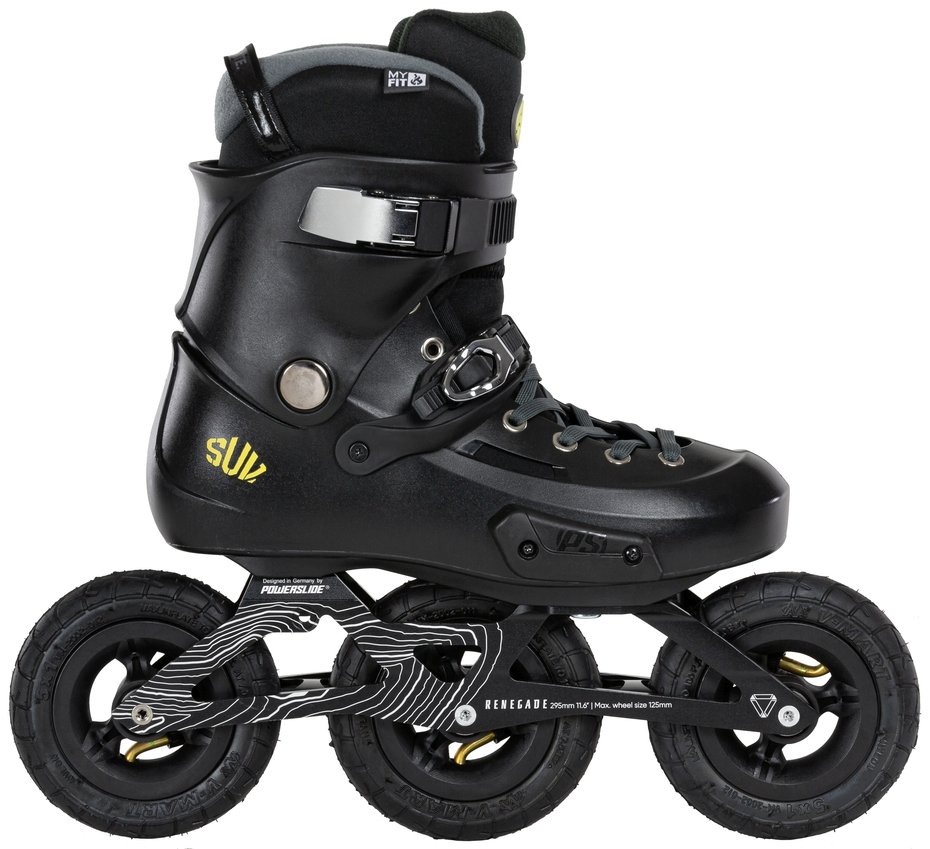
Zoom Renegade 125’s frame fits wheels of 125 mm diameter, so smaller than ones used in Next Edge. Thanks to it, the centre of gravity is lower, comparable to regular skates on 125 mm wheels. This, of course, impacts control in a positive manner. Also, the weight difference between this skate and two-wheeled Next Edge is marginal. While Zoom skate weights 1965g in size EU41/42, Next is 1910g in size EU42/43.
You have probably noticed that Zoom have a different shell sizing in comparison to Next. In addition, Zoom are shaped a bit differently in ankle area and wider. Thanks to it, you have more options when it comes to finding a skate which fits your feet anatomy.
What about the ride itself? Zoom Renegade should work in conditions when Next Edge becomes a bit inadequate. It will roll over obstacles and gaps much better and provide better stability when going downhill.
These skates are also a very good option for doing stunts. Take them to a pump track or dirt park and go wild. Their relatively low weight makes jumping in them easy enough and three wheels plus low centre of gravity contribute to stable landings.
There are some downsides, though. The skates will be a little slower than Next Edge on flat ground, both because smaller wheels and because three of them have more footprint, meaning more roll resistance. This is why we do recommend getting poles alongside these. Three wheels also means a higher cost of maintenance – when it’s tie to replace the tires, you need to get 6 of them instead of 4.
Next Outback 150
This model is hands down the most demanding when it comes to user’s skill. It fits three 150 mm diameter wheels in a frame measuring 325 mm. What does it mean?
We’ll shall start with downsides this time, to save best for the latter.
First of all, weight. The skates are heavy – 2265g in size EU42/43. A whole 355 g more than Next Edge – and you’ll feel it during skating. Another thing is limited manoeuvrability – the frame is almost as long as speed-skating, fitting 4x100 mm wheel setup, one. Coupled with higher centre of gravity, than in case of Zoom Renegade, it makes Next Outback the most difficult to handle of the three current models. Three 150 mm wheels are slow to get up to speed on a flat ground. This means that poles are a must this time if you thing about anything other than riding downhill.

What about upsides?
Well, the skates will roll over almost anything – like a tank. This means that even roughest terrain, where Zoom Renegade is barely doing its job, should be manageable. The longer frame does mean worse agility, but also better stability, which comes in handy when going downhill. Especially if you want to go fast down mountain bike paths, Next Outback definitely win.
To sum it up – demanding skate, for demanding users. The steep learning curve is rewarded, though.
That’s not all!
Powerslide offers an option to purchase framesets alone. All versions – Edge 150, Renegade 125 and Outback 150 are available to buy.
This gives you an option to put together an equivalent to now de-listed Next Renegade 125 model, if you want the 125 mm wheels but prefer Next boot instead of Zoom one.
Most importantly, this gives you an option to attach these frames to any Trinity compatible boot. Which doesn’t mean that you should do this with ANY boot. It must be high-cut, supportive, durable and rigid, otherwise you are putting yourself at risk of a serious injury.
Apart from Next and Zoom, the good picks are carbon-based skates like Hardcore Evo Trinity, Tau and Arise. Kaze boot will do the job, too and was even sold as stock option with SUV frames few years ago. We do not recommend to try coupling off-road frames with fitness softboots or low-cut speedskating boots. For sake of your ankles, that is.
A brake? Yes, you can have one!
Powerslide have developed a brake which can help you to manage the speed when going downhill. It is compatible with all 2nd gen Trinity SUV frames, but not compatible with all the boots. How to check if your frames are 2nd gen? Simple, they will have two holes in sidewalls right under the heel of the skate.
How the brake works? A bit similar as one in regular skates when it comes to braking position – you need to push the braking foot forward, but the difference is, you cannot lift your toes up. In fact, you should apply as much pressure with your calf on back cuff edge as possible.
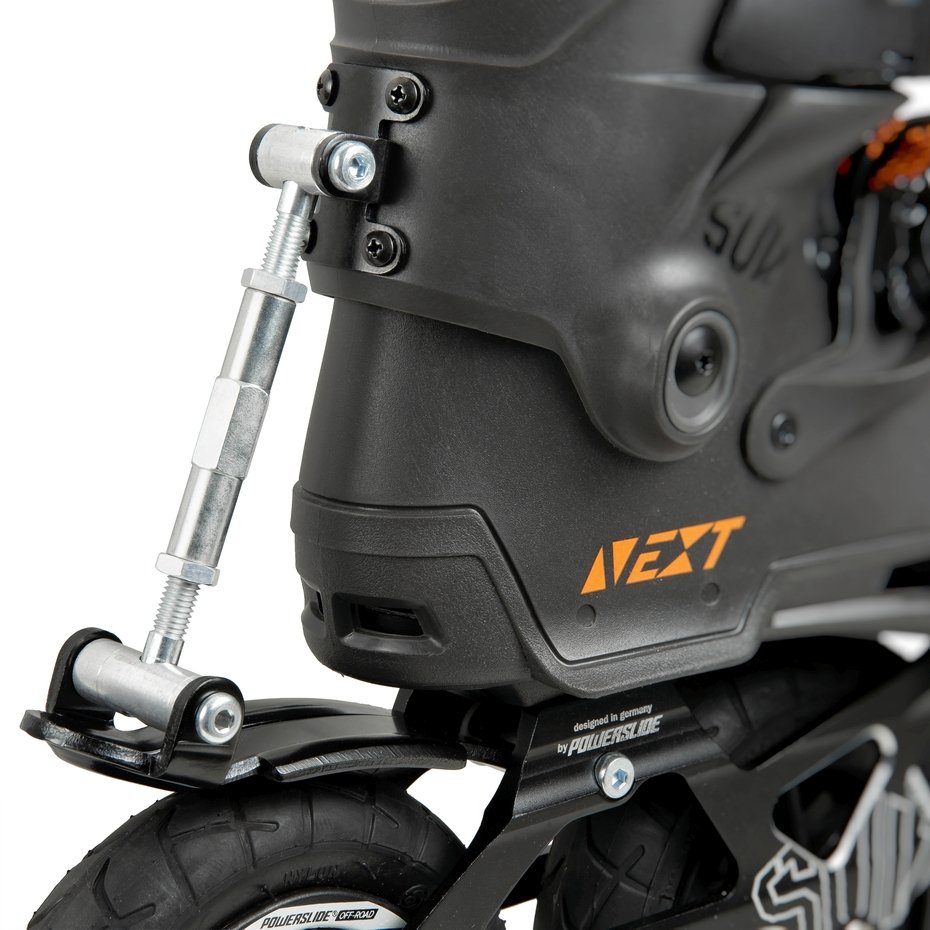
The brake must be attached to external cuff and installation does require some skill and tools (you need to remove the cuff and drill holes in it). It is also not guaranteed that it will work with every boot – Next and Zoom are tested, but more minimalistic cuff, like one found in Hardcore Evo, may not work. You may need to swap your cuffs to different ones, which may not be a straightforward process. Also, the brake won’t work in case of new Kaze boot, which does not have any external cuff at all.
One, six, five – SUV can be your type.
Apart from models made for Trinity mounting, Powerslide still offers an older frame made for 165 mm mount spacing. It is an equivalent of Renegade 125 – fits three wheels of 125 mm diameter and have the same length of 295 mm. In theory, these will fit under any boot with 165 mm mounting, but you have to remember that their position in relation to your foot may differ if there is no longitudinal adjustment system.
The best use case are plastic hardboots or carbon freeskates with aluminium blocks for frame mounting. If they have multiple threaded holes for screws (like FR3, FR2 and FR1) or mounting point moving along the rail (like in case of Powerslide Imperial), that’s perfect, as you do not have to worry if frame will be properly centred.

In case of skates which come with blocks with just one threaded hole (i.e. RB Pro/Cruiser or Twister Edge) , it is best to check first. If you have any doubts - you can always contact the shop.
We do not recommend using these frames with boots where mounting is directly on plastic. The forces working around the bolts, created by skating on tall frames in rough terrain, may weaken the underside of the shell over time.
What else? Pick skates with good ankle support, of course!
Aggressive off-road inline?
If you have UFS-equipped boots, then there’s something for you, too. Powerslide’s aggressive frames brand, Kizer, has released a SUV 125 Ti frame as a full setup and frame only. Once again, the specs are the same as in case of Renegade 125 – 3x125 mm wheel setup in 295 mm long frame.
It is very important to have a boot with strong shell-soulplate-frame connection. It is good if the material which soulplates are made of is thick and rigid. A good example of such skates are USD Sway. Shell is the same as in Zoom, while soulplate is very solid and firmly attached to the shell.
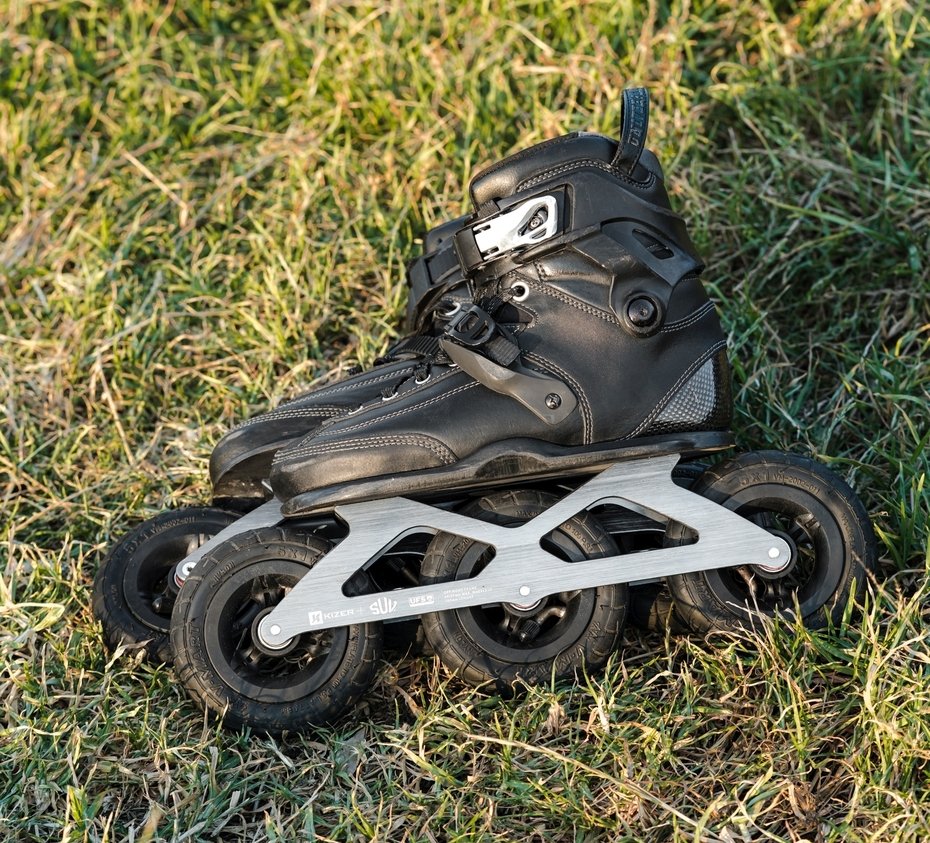
Bear in mind that aggressive skates are quite often more flexible in the ankle area than freeskating ones. It is better to pick those which come with higher cuffs and lock the heel in place well. You may also consider modding your skates with 45 degree buckles to achieve even better heel lock and add some rigidity.
The frames can be mounted to boots like Seba CJ without soulplates, of course. If you want to use them with one of the new UFR models (without a soulplate, mounted directly to the boot) you may want to get a set of FR UFS Raising plates, which will fill out the holes for UFS nubs and make frame and boot connection to “work” less. Be warned, though, that because frames and raising plates come from two different manufacturers, there may be some fiddling or even modding required to fit them together.
To sum it up – if you want to skate in the forest in a pair of aggressive inlines, it is perfectly doable, just do not expect to be able to grind logs :)
Aaaaaannnnd finish! (I swear)
When I sat down to write this article, I was under inane impression that it will take two pages of text at best. You know, this seemed simple – only one company makes off-road skates, there aren’t that much options. It ended up being 5,5 pages long, whew. I think that it shows that even though there aren’t that many choices, they offer a wide range of possibilities.
Remember that I haven’t covered the more roller-ski like models. There’s a beast called Grave Digger among them – low, 60 cm long (no joke here) frame with two 200 mm diameter wheels. Seeing it in action is jaw-dropping.
But that’s all for now – on behalf of Bladeville team, please accept an invitation to go out and skate some off-road tracks!


